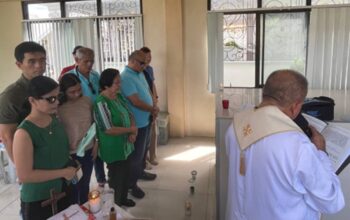
THE felling of Acacia trees in barangay Taloto in the city is illegal, Atty. Jordan Pizarras said in his facebook post last week.
“It is clear from my posts which have remained unrebutted, by the DENR – both PENRO and CENRO, and the Shell Station- that the cutting of the four ancient heritage trees was illegal and constitutes a violation of PDs 705 and 953,” he said. And he followed it up with “The question is who will be held responsible?’
This came following an uproar over the cutting surfaced last week after Bishop Albert Uy’s facebook post, informing the people of the felled trees and urging officials concerned to step in.
The provincial board chaired by Vice-Gov. Dionisio Victor A. Balite conducted an investigation in-aid-of legislation last week over the cutting of the said-to-be centennial acacia trees allegedly without permit.
Bishop’s post showed his estimate of the acacia trees’ age (about a hundred years old) in said place where they (seminarians) used to take shed and wait for the passenger jeep after he entered in seminary in 1979. The post generated 1,300 likes, 70 shares and 153 comments from netizens as of April 4, 2023.
He warned that the city will suffer more heat after the news item by this writer landed in Bohol Chronicle April 2 issue.
“Tagbilaran City was one of the three cities on the Heat List of the PAGASA the past weeks as El Nino sets in. Unya, karon namutol pa gyud tag mga dagkong kahoy. Sigurado, mosamot ta ka init ani. Luoy mga Bolanon. Ang nagpaputol sa mga kahoy nagpahayahay lang,” the bishop cried foul.
Pizarras challenged the city mayor to take control of the place where the acacias were cut, which he considered as a crime scene.
“To allay the fears of Tagbilaranons and Boholanos that the acts of the good mayor are ALL for show and that she is not sincere – she should immediately take possession of the premises, and request the police to cordon-off the area as a crime scene to preserve the evidence but remove the tarps so everybody can see how the trees were cut-down as a lesson for all,” Pizarras said.
Pizarras also urged the mayor to order officials concerned to explain why the said building permit was issued in the first place and to make public the building permit application and its supporting documents for the sake of transparency and good governance. He said this to dispel any suspicion on the part of the city government.
Pizarras argued that the cut four (4) acacia trees were not part in the designs of the gas station submitted to the city for building permit. This could have alerted the city officials where are the acacia trees.
“Since the four trees were not in the designs – why did the officials grant the permit? Were they not aware of those four ancient heritage trees? Did they not conduct an ocular inspection at the very least? Everybody in Tagbilaran and its neighboring towns know about these trees because they give the area a Baguio City-like feel.”
This burden now lies with the city mayor “to convince the people of Tagbilaran that her acts are not all for a show” and that her officials are not sleeping on their job.
LAW VS. CUTTING TREES
Republic Act No. 3571 approved on June 21, 1963 prohibits “the cutting, destroying or injuring of planted or growing trees flowering plants and shrubs or plants of scenic value along public roads, in plazas, parks, school premises or in any other public pleasure ground.”
It provides in section 3 that “No cutting, destroying, or injuring of planted or growing trees, flowering plants and shrubs or plants of scenic value along public roads, in plazas parks, school premises or in any other public ground shall be permitted save when the cutting, destroying, or injuring of same is necessary for public safety, or such pruning of same is necessary to enhance its beauty and only upon the recommendation of the committee mentioned in the preceding section, and upon the approval of the Director of Parks and Wildlife. The cutting, destroying, or pruning shall be under the supervision of the committee.
It punishes violations under section 4. Any person who shall cut, destroy or injure trees, flowering plants and shrubs or plants of scenic value mentioned in the preceding sections of this Act, shall be punished by prisión correccional in its minimum period to prisión mayor in its minimum period.
The said law is enacted (section 1) “In order to promote and conserve the beauty of objects of scenic and ornamental value along public places and help preserve cool, fresh and healthful climate, it is the policy of the Government to cherish, protect and conserve planted or growing trees, flowering plants and shrubs or plants of ornamental value along public roads, in plazas, parks, school premises or in any public ground.
ACACIA NOT SUPPOSEDLY CUT
The said to be centuries-old acacia trees were not supposedly be cut, City Mayor Jane C. Yap clarified in her facebook post.
“Unya base sa site development plan nga gisubmit nila sa City OBO ang dagko na kahoy pwede ra unta dile putlon kay nasud man kini sa road setback,” the mayor said. (Based on the development plan submitted to the city Office of Building Officer (OBO), the said trees are not supposed to be cut since these are within the road setback).
The cutting off the acacia trees along the once Taloto’s Baguio drive to pave the way for a business establishment has generated public noise especially on social media following the Bishop’s expose.’
The mayor, who suspended the building permit of Shell for a gasoline station construction, said that the cutting incident is a “wake up call.” She added that cut acacia is a big loss to the Baguio drive. She said that the building permit was first issued prior to DENR’s cut permit.
She explained that the city will exhaust all means, including lobbying for a mandatory issuance of a clearance from the city before the DENR could issue tree cutting permit.
ACACIA IN GUINDULMAN
Acacia tees lined up along the national highway in barangay Guio-ang were eyed to be cut with the reported blessing of the DENR about two years back. A big tarp posted in the roadside informed the public of the said plan.
Bohol media personalities swooped down the place to inquire. It was learned that some residents of the place opposed to the plan. Two years after, the three acacia trees remain standing until now.
It was not known why the DENR and the Department of Public works and Highways did not implement the plan apparently to pave way for road widening, according to a resident here. (rvo)



